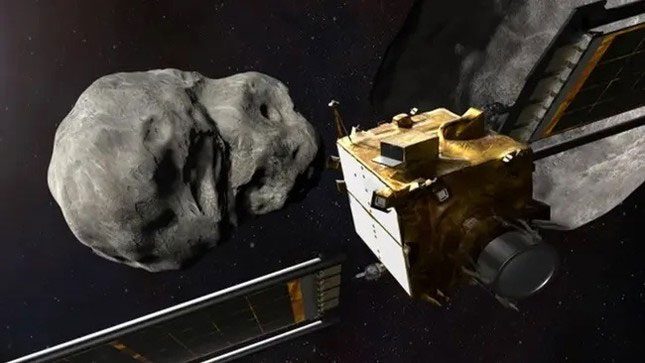The NASA spacecraft designed to redirect the binary asteroid DART appears to have reshaped the asteroid Dimorphos after colliding with it in September 2022.
Scientists have discovered that the asteroid involved in the Double Asteroid Redirection Test (DART) by NASA may have changed following the impact. A new investigation into the aftermath of this collision has revealed that the asteroid in the binary system resembles a “pile of rubble.”
DART crashed into the asteroid Dimorphos, which orbits the larger space rock Didymos, on September 26, 2022.

Illustration of NASA’s DART spacecraft approaching the moon surrounding the Didymos asteroid. (Photo: NASA / Johns Hopkins APL).
The purpose of this collision was to determine whether a kinetic impact could alter the orbit of an asteroid around a larger object and if this method could be used to push a space rock if its trajectory was headed towards Earth.
Six months after the collision, NASA confirmed the mission was successful, with the time it took Dimorphos to orbit its companion asteroid decreasing by 33 minutes.
How did the asteroid Dimorphos change?
After the impact, one of Dimorphos’s orbits around Didymos took approximately 11 hours and 23 minutes. The latest research indicates that the effects of the collision may have significantly impacted the shape of Dimorphos.
A team led by scientist Sabina Raducan from the University of Bern (Switzerland) used advanced computer modeling to determine for the first time that Dimorphos is a loose asteroid filled with debris. This also suggests that the small planet may have formed from material ejected from its larger partner asteroid, Didymos.
The simulations that best matched the observations of the impact indicated that Dimorphos has weak cohesion.
Raducan mentioned that DART revealed other unexpected findings. She stated: “Dimorphos has a very different composition compared to the asteroids Ryugu and Bennu, yet their responses to impacts seem quite similar. For all these asteroids, the process of crater formation occurs in a low-gravity, low-cohesion environment, where the craters grow significantly larger.”
Additionally, according to the team’s calculations, rather than just creating a crater, the DART impact seems to have completely reshaped Dimorphos. This occurred through a process known as global deformation.
The reshaping appears to have caused the exterior of the satellite to be reconstructed with material from within. The team’s simulations showed that approximately 0.5% to 1% of Dimorphos’s mass was ejected due to the impact of DART, while 8% of its mass was redistributed, leading to significant reshaping and reconstruction of the asteroid’s surface.
Raducan added that these findings suggest that the structural integrity and response to impacts of smaller asteroids could be profoundly influenced by their internal composition and material distribution.
The team’s results could help scientists gain a better understanding of the Dimorphos and Didymos asteroid system and analyze the dynamics of other binary asteroids in the solar system.
The main goal of DART is to test planetary defense methods. This experiment will provide valuable information for the development of future asteroid exploration missions.


















































